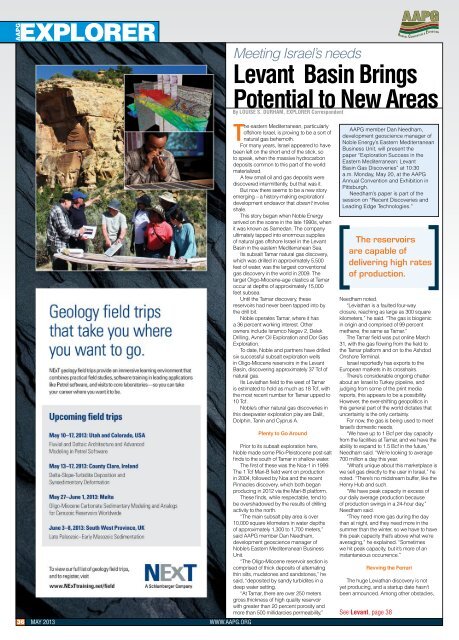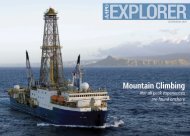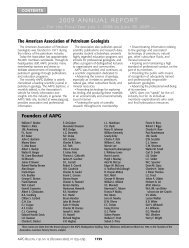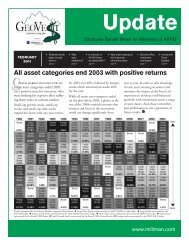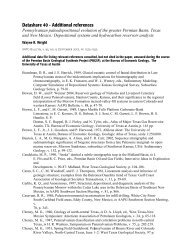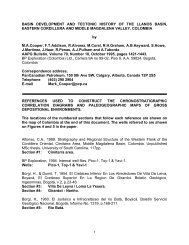Download - American Association of Petroleum Geologists
Download - American Association of Petroleum Geologists
Download - American Association of Petroleum Geologists
You also want an ePaper? Increase the reach of your titles
YUMPU automatically turns print PDFs into web optimized ePapers that Google loves.
AAPG<br />
EXPLORER<br />
Meeting Israel’s needs<br />
Levant Basin Brings<br />
Potential to New Areas<br />
By LOUISE S. DURHAM, EXPLORER Correspondent<br />
36 MAY 2013 WWW.AAPG.ORG<br />
The eastern Mediterranean, particularly<br />
<strong>of</strong>fshore Israel, is proving to be a sort <strong>of</strong><br />
natural gas behemoth.<br />
For many years, Israel appeared to have<br />
been left on the short end <strong>of</strong> the stick, so<br />
to speak, when the massive hydrocarbon<br />
deposits common to this part <strong>of</strong> the world<br />
materialized.<br />
A few small oil and gas deposits were<br />
discovered intermittently, but that was it.<br />
But now there seems to be a new story<br />
emerging – a history-making exploration/<br />
development endeavor that doesn’t involve<br />
shale.<br />
This story began when Noble Energy<br />
arrived on the scene in the late 1990s, when<br />
it was known as Samedan. The company<br />
ultimately tapped into enormous supplies<br />
<strong>of</strong> natural gas <strong>of</strong>fshore Israel in the Levant<br />
Basin in the eastern Mediterranean Sea.<br />
Its subsalt Tamar natural gas discovery,<br />
which was drilled in approximately 5,500<br />
feet <strong>of</strong> water, was the largest conventional<br />
gas discovery in the world in 2009. The<br />
target Oligo-Miocene-age clastics at Tamar<br />
occur at depths <strong>of</strong> approximately 15,000<br />
feet subsea.<br />
Until the Tamar discovery, these<br />
reservoirs had never been tapped into by<br />
the drill bit.<br />
Noble operates Tamar, where it has<br />
a 36 percent working interest. Other<br />
owners include Isramco Negev 2, Delek<br />
Drilling, Avner Oil Exploration and Dor Gas<br />
Exploration.<br />
To date, Noble and partners have drilled<br />
six successful subsalt exploration wells<br />
in Oligo-Miocene reservoirs in the Levant<br />
Basin, discovering approximately 37 Tcf <strong>of</strong><br />
natural gas.<br />
Its Leviathan field to the west <strong>of</strong> Tamar<br />
is estimated to hold as much as 18 Tcf, with<br />
the most recent number for Tamar upped to<br />
10 Tcf.<br />
Noble’s other natural gas discoveries in<br />
this deepwater exploration play are Dalit,<br />
Dolphin, Tanin and Cyprus A.<br />
Plenty to Go Around<br />
Prior to its subsalt exploration here,<br />
Noble made some Plio-Pleistocene post-salt<br />
finds to the south <strong>of</strong> Tamar in shallow water.<br />
The first <strong>of</strong> these was the Noa-1 in 1999.<br />
The 1 Tcf Mari-B field went on production<br />
in 2004, followed by Noa and the recent<br />
Pinnacles discovery, which both began<br />
producing in 2012 via the Mari-B platform.<br />
These finds, while respectable, tend to<br />
be overshadowed by the results <strong>of</strong> drilling<br />
activity to the north.<br />
“The main subsalt play area is over<br />
10,000 square kilometers in water depths<br />
<strong>of</strong> approximately 1,300 to 1,700 meters,”<br />
said AAPG member Dan Needham,<br />
development geoscience manager <strong>of</strong><br />
Noble’s Eastern Mediterranean Business<br />
Unit.<br />
“The Oligo-Miocene reservoir section is<br />
comprised <strong>of</strong> thick deposits <strong>of</strong> alternating<br />
thin silts, mudstones and sandstones,” he<br />
said, “deposited by sandy turbidites in a<br />
deep water setting.<br />
“At Tamar, there are over 250 meters<br />
gross thickness <strong>of</strong> high quality reservoir<br />
with greater than 20 percent porosity and<br />
more than 500 millidarcies permeability,”<br />
AAPG member Dan Needham,<br />
development geoscience manager <strong>of</strong><br />
Noble Energy’s Eastern Mediterranean<br />
Business Unit, will present the<br />
paper “Exploration Success in the<br />
Eastern Mediterranean: Levant<br />
Basin Gas Discoveries” at 10:30<br />
a.m. Monday, May 20, at the AAPG<br />
Annual Convention and Exhibition in<br />
Pittsburgh.<br />
Needham’s paper is part <strong>of</strong> the<br />
session on “Recent Discoveries and<br />
Leading Edge Technologies.”<br />
The reservoirs<br />
are capable <strong>of</strong><br />
delivering high rates<br />
<strong>of</strong> production.<br />
Needham noted.<br />
“Leviathan is a faulted four-way<br />
closure, reaching as large as 300 square<br />
kilometers,” he said. “The gas is biogenic<br />
in origin and comprised <strong>of</strong> 99 percent<br />
methane, the same as Tamar.”<br />
The Tamar field was put online March<br />
31, with the gas flowing from the field to<br />
the Tamar platform and on to the Ashdod<br />
Onshore Terminal.<br />
Israel reportedly has exports to the<br />
European markets in its crosshairs.<br />
There’s considerable ongoing chatter<br />
about an Israel to Turkey pipeline, and<br />
judging from some <strong>of</strong> the print media<br />
reports, this appears to be a possibility.<br />
However, the ever-shifting geopolitics in<br />
this general part <strong>of</strong> the world dictates that<br />
uncertainty is the only certainty.<br />
For now, the gas is being used to meet<br />
Israel’s domestic needs.<br />
“We have up to 1 Bcf per day capacity<br />
from the facilities at Tamar, and we have the<br />
ability to expand to 1.5 Bcf in the future,”<br />
Needham said. “We’re looking to average<br />
700 million a day this year.<br />
“What’s unique about this marketplace is<br />
we sell gas directly to the user in Israel,” he<br />
noted. “There’s no midstream buffer, like the<br />
Henry Hub and such.<br />
“We have peak capacity in excess <strong>of</strong><br />
our daily average production because<br />
<strong>of</strong> production swings in a 24-hour day,”<br />
Needham said.<br />
“They need more gas during the day<br />
than at night, and they need more in the<br />
summer than the winter, so we have to have<br />
this peak capacity that’s above what we’re<br />
averaging,” he explained. “Sometimes<br />
we hit peak capacity, but it’s more <strong>of</strong> an<br />
instantaneous occurrence.”<br />
Revving the Ferrari<br />
The huge Leviathan discovery is not<br />
yet producing, and a startup date hasn’t<br />
been announced. Among other obstacles,<br />
See Levant, page 38


